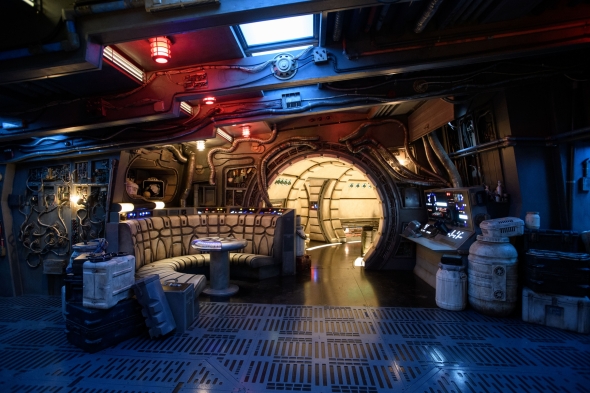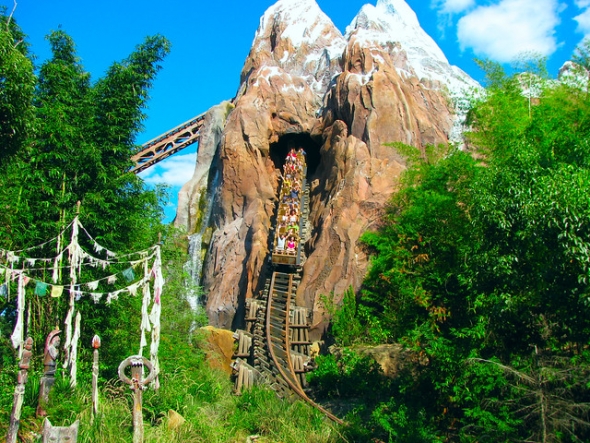
There are many ways to build a successful theme park. Children’s Fairyland in Oakland, California combines old-fashioned charm and community-focused events with a child-only policy that prevents childless adults (and unaccompanied kids) from wandering through its 10-acre lot. Six Flags has established itself as the champion of thrill-seekers, with over 160 stomach-twisting roller coasters scattered among its 15 locations. With current portals in Hollywood, Orlando, Japan, and Singapore, Universal Studios Theme Parks has redefined immersive intellectual property-inspired attractions, from its harrowing Walking Dead walkthrough to its famed Wizarding World of Harry Potter experience.
The Disney Parks, meanwhile, have settled comfortably in the intersection between nostalgia and innovation, blending IP-based attractions with cutting-edge technology in ways that used to feel fresh and original. Disney isn’t known for having the most extreme roller coasters, like Six Flags, or the most interactive capabilities, like Universal, but its commitment to expanding the scope of the theme park industry has fueled an expectation for an ongoing stream of new and exciting attractions, festivities, and tech.
Image: Disney
These days, that’s proving an increasingly difficult model to build on. Disney’s competitors have matched—and, in some ways, surpassed—its ability to complement lush, detailed theming with Audio-Animatronics, trackless and Omnimover-powered attractions, dynamic live entertainment, and more. It was of some surprise, then, when Disney Parks chairman Bob Chapek spoke to this disadvantage during the opening of Star Wars: Galaxy’s Edge last month:
“We’ve got the wealth of riches, we’ve got an embarrassment of riches, and we don’t want to do anything that anybody else can do,” Chapek told the press. “A lot of times, people say, ‘Why does everything have to have a franchise orientation?’ Because that’s our barrier to entry. Because if any of our competitors had our intellectual property, guess what? They would be doing the exact same thing we’re doing, but they don’t have it. […] And that’s where we have a franchise orientation. And frankly, that’s why the Walt Disney Company far and away outperforms all of our peers.”
It’s unusual to see this level of self-awareness publicized in the Disney community, especially as this kind of ‘franchise orientation’ appears to run counter to Walt’s original vision for his theme parks. But is that really the case? Does IP exclusivity preclude the Disney Parks from pushing the envelope with original attractions and boundary-expanding technological advancements? And does their grip on franchises like Star Wars and Avatar necessarily mean that they’re a cut above the rest?
This isn’t the first time the Disney Parks have been ‘franchise-oriented’
Image: Patrick McGarvey, Flickr (license)
The last truly original (i.e. not IP-based) ride to debut at any stateside Disney park was Expedition Everest, which was planted in Disney’s Animal Kingdom on April 7, 2006. Other parks’ most recent attractions include Soarin’ Over California (Epcot, 2005), Astro Orbitor (Disneyland, 1998), and the Tomorrowland Transit Authority PeopleMover (Magic Kingdom, 1975). Disney California Adventure has not debuted a new original attraction (with the exception of the Soarin’ overlay in 2016) since it first opened its gates to the public in February 2001, with California Screamin’, Golden Zephyr, Orange Stinger, Maliboomer, and Grizzly River Run among the non-IP rides in its rotation. Disney’s Hollywood Studios, meanwhile, has exclusively dealt in IP-based rides; the closest they came to developing a ride with a unique story and characters was with the debut of Rock ‘n’ Roller Coaster Starring Aerosmith in 1999.
There might be any number of reasons why Disney has directed its focus away from original story-based rides like Pirates of the Caribbean, Matterhorn Bobsleds, Haunted Mansion, and Big Thunder Mountain Railroad over the years—rides that have since entered the untouchable pantheon of theme park classics—but most of them boil down to this: there is a noticeable and increasing demand for immersive experiences built on über-successful franchises. And, while it’s hardly romantic to suggest that Disney is driven by a need to boost its bottom line, that it knows more guests will come flocking through the turnstiles for a Guardians of the Galaxy rollercoaster than a whimsical dark ride about an imaginative purple dragon, it would be just as foolhardy to believe that there ever existed a time when the Disney Parks were not primarily viewed as a money-making machine.
As Disney expanded its partnerships with Pixar and Lucasfilm and acquired more lucrative franchises—Star Wars first and foremost among them—the demand for IP-based attractions appeared to grow by leaps and bounds as well. In 2012, Disney California Adventure’s Cars Land became the first fully immersive Disney-themed land, while Pandora - The World of Avatar opened to rave reviews upon its debut in 2017. With such a wealth of films and characters to draw from, the need to pair unique, never-before-told stories with new roller coasters and dark rides dwindled. Disney hasn’t lost the ability to innovate on the same level as the original Imagineers did, but they’re far less likely to roll the dice with something as creatively ambitious as the Carousel of Progress or “it’s a small world” when it has galaxies of Star Wars, Marvel, and Pixar characters to play around with instead.



Comments
The "franchise orientation" is killing the Disney theme parks especially Walt Disney World in Florida.